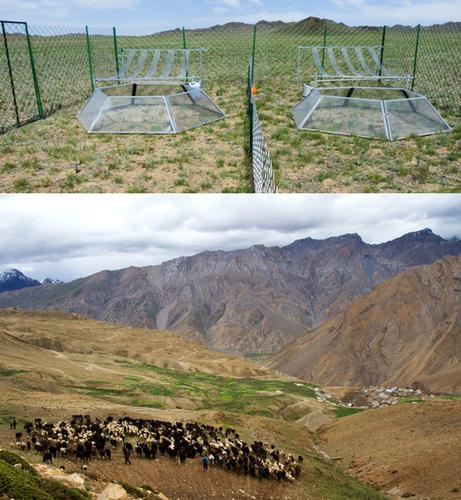当前位置:
X-MOL 学术
›
J. Appl. Ecol.
›
论文详情
Our official English website, www.x-mol.net, welcomes your
feedback! (Note: you will need to create a separate account there.)
Grazing and climate change have site‐dependent interactive effects on vegetation in Asian montane rangelands
Journal of Applied Ecology ( IF 5.0 ) Pub Date : 2020-10-17 , DOI: 10.1111/1365-2664.13781 Mayank Kohli 1 , Tserennadmid Nadia Mijiddorj 2, 3 , Kulbhushansingh Ramesh Suryawanshi 4, 5 , Charudutt Mishra 4, 5 , Bazartseren Boldgiv 2 , Mahesh Sankaran 6, 7
中文翻译:

放牧和气候变化对亚洲山地牧场的植被具有取决于地点的互动影响
更新日期:2020-10-17
Journal of Applied Ecology ( IF 5.0 ) Pub Date : 2020-10-17 , DOI: 10.1111/1365-2664.13781 Mayank Kohli 1 , Tserennadmid Nadia Mijiddorj 2, 3 , Kulbhushansingh Ramesh Suryawanshi 4, 5 , Charudutt Mishra 4, 5 , Bazartseren Boldgiv 2 , Mahesh Sankaran 6, 7
Affiliation

|
- Climate over Asian montane rangelands is changing faster than the global average, posing serious threats to the future of the region's livestock‐based economies and cultures. Effects of climate change on rangeland vegetation likely depend on grazing by herbivores but the potential responses of vegetation to such changes in climate and grazing regimes remain unclear.
- We examined vegetation responses to experimentally simulated climate change (warming, drought and increased rainfall) and grazing (clipping vegetation) between 2015 and 2018 at two mountain rangeland sites: Spiti valley, in the Indian Trans‐Himalaya and Tost, in the Gobi‐Altai Mountains in Mongolia.
- Clipping and climate change manipulations interactively reduced vegetation cover and biomass but did not affect species richness. Treatment effects and their interactions varied between sites. In ungrazed plots, vegetation cover and biomass declined sharply in response to warming (18%–35%) and drought (20%–50%) at the two sites, and, surprisingly also declined slightly in response to increased rainfall (20%) at Tost. While the effects of climate treatments were largely similar in the grazed and ungrazed plots in Tost, they were larger in the ungrazed plots in Spiti. The decline in vegetation cover was driven by a decline in the cover of both forbs and grasses.
- In combination, grazing and warming (Tost) or drought (Spiti) had sub‐additive effects, that is, the decrease in vegetation cover in response to grazing and warming/drought was less than the sum of their independent effects but greater than the effect of either manipulation alone. Of the two, warming had a greater effect than drought at the more arid site (Tost), whereas drought had a larger effect at the more mesic site (Spiti).
- Synthesis and applications. Our findings show that future changes in climate, including just over 1°C of warming, could undermine the sustainability of pastoral economies and the persistence of wildlife across Asian montane rangelands. Furthermore, grazing by herbivores will play an important role in mediating rangeland responses to climate change; thus, pasture management in concert with local pastoralists will be crucial in mitigating the adverse effects of climate change on rangelands, pastoral livelihoods and wildlife populations.
中文翻译:

放牧和气候变化对亚洲山地牧场的植被具有取决于地点的互动影响
- 亚洲山地牧场的气候变化速度快于全球平均水平,对该地区以牲畜为基础的经济和文化的未来构成了严重威胁。气候变化对牧场植被的影响可能取决于草食动物的放牧,但尚不清楚植被对这种气候和放牧方式变化的潜在反应。
- 我们研究了2015年至2018年之间两个高山草原站点(印度Trans-Himalaya的Spiti谷和戈壁Altai的Tost)对植被对实验模拟的气候变化(变暖,干旱和降雨增加)和放牧(植被减少)的响应在蒙古的山脉。
- 修剪和气候变化操纵交互地减少了植被覆盖和生物量,但没有影响物种的丰富度。不同部位的治疗效果及其相互作用也各不相同。在未湿润的土地上,两个地点的植被覆盖和生物量因变暖(18%–35%)和干旱(20%–50%)而急剧下降,令人惊讶的是,由于降雨增加(20%),植被覆盖率和生物量也略有下降在托斯特。尽管在托斯特的放牧和未绿化土地上,气候处理的效果在很大程度上相似,但在斯皮提的未绿化土地中,气候处理的影响更大。植被覆盖率的下降是由于草和草的覆盖率下降所致。
- 综合而言,放牧和变暖(Tost)或干旱(Spiti)具有次加性效应,也就是说,由于放牧和变暖/干旱,植被覆盖的减少小于其独立影响的总和,但大于其影响。任一个操纵。在这两个地区中,变暖比干旱地区(Tost)的干旱影响更大,而干旱比偏斜地区(Spiti)的干旱影响更大。
- 综合与应用。我们的研究结果表明,未来气候变化,包括刚刚超过1°C的变暖,可能会破坏牧草经济的可持续性以及亚洲山地牧场中野生生物的持续生存。此外,以草食动物为食的放牧将在调解牧场对气候变化的反应中发挥重要作用;因此,与当地牧民合作进行牧场管理对于减轻气候变化对牧场,牧民生计和野生动植物种群的不利影响至关重要。











































 京公网安备 11010802027423号
京公网安备 11010802027423号